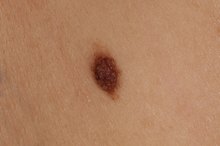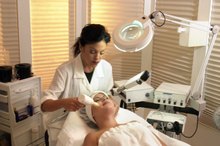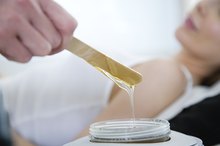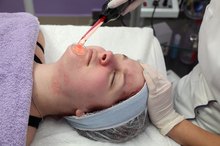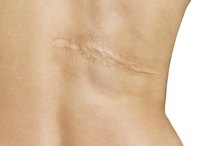What does fact checked mean?
At Healthfully, we strive to deliver objective content that is accurate and up-to-date. Our team periodically reviews articles in order to ensure content quality. The sources cited below consist of evidence from peer-reviewed journals, prominent medical organizations, academic associations, and government data.
- Indian Journal of Dermatology: Acne Vulgaris Treatment: The Current Scenario
- Indian Journal of Dermatology: Acne Vulgaris Treatment: The Current Scenario
The information contained on this site is for informational purposes only, and should not be used as a substitute for the advice of a professional health care provider. Please check with the appropriate physician regarding health questions and concerns. Although we strive to deliver accurate and up-to-date information, no guarantee to that effect is made.
How Do I Get Rid of Acne Craters in the Face?
Mild and moderate cases of acne may clear up without scarring but more severe cases can cause permanent tissue damage. (Ref. 1) Some people are left with deep craters or depressions in the skin, called atrophic scars, that occur due to a loss of tissue. People with darker skin, including African Americans, tend to develop raised scars or keloids. Mild to moderate craters can be treated with chemicals, lasers and abrasion to resurface the skin. More severe scars may require one of several types of surgery to improve the appearance of the skin. Home remedies are not recommended.
Chemical Treatments
A series of chemical peels at the dermatologist's office can help to resurface the skin and stimulate it to begin to fill in the craters with collagen. (Ref. 4) This procedure involves spreading one or more chemicals such as salicylic acid, pyruvic acid, glycolic acid or trichloroacetic acid on the face, then removing it along with a superficial layer of skin. (Ref. 4) Between office treatments, you may also be asked to apply chemicals to your skin at home. Depending on the substance used, you may experience side effects such as skin irritation, changes in skin color or sensitivity to light. (Ref. 4)
- A series of chemical peels at the dermatologist's office can help to resurface the skin and stimulate it to begin to fill in the craters with collagen.
- (
Noninvasive Treatments
How to Get Rid of Stitch Scars on the Face
Learn More
Two types of laser treatments are available to improve the appearance of acne craters. Ablative lasers resurface the skin but can cause unpleasant side effects. Non-ablative lasers can successfully treat some types of atrophic scars with fewer side-effects. (Ref. 2, 4) Another type of noninvasive treatment, called tretinoin-iontophoresis, utilizes special equipment that improves the way that tretinoin, a medication, penetrates the skin and treats atrophic scars 5. (Ref. 2, 4)
- Two types of laser treatments are available to improve the appearance of acne craters.
Dermabrasion
Two types of dermabrasion are available for the resurfacing of skin affected by atrophic scars. Microdermabrasion, the less invasive form, is a form of exfoliation that removes the outermost layer of the epidermis painlessly and without side effects. Dermabrasion, which must be done under general or local anesthesia, removes the epidermis layer and is more effective with deep craters. (Ref 2, 4) Both procedures are performed with specialized equipment in the dermatologist's office.
- Two types of dermabrasion are available for the resurfacing of skin affected by atrophic scars.
- Dermabrasion, which must be done under general or local anesthesia, removes the epidermis layer and is more effective with deep craters.
- (
Surgical Options
Skin-Care Alternatives to Chemical Peels
Learn More
Depending on the type and depth of the craters, a surgical procedure may be warranted. Your doctor may decide that surgically removing the craters and closing the skin with sutures will be adequate. In the case of deeper craters, your doctor may elect to fill the opening with collagen, apply a skin graft or implant fat from another area of the body. (Ref. 5; ref. 6 p. 154 and other pages)
- Depending on the type and depth of the craters, a surgical procedure may be warranted.
- In the case of deeper craters, your doctor may elect to fill the opening with collagen, apply a skin graft or implant fat from another area of the body.
- (
Related Articles
References
- The Merck Manual Professional Edition: Acne Vulgaris
- Journal of Clinical & Experimental Dermatology Research: The Management of Atrophic Acne Scars: Overview and New Tools
- Cosmetic Dermatology: Products and Procedures; Zoe Diana Draelos (ed.)
- Indian Journal of Dermatology: Acne Vulgaris Treatment: The Current Scenario
- Step By Step Treatment of Acne Scars; Niti Khunger, M.D.
- Saint-jean M, Khammari A, Jasson F, Nguyen JM, Dréno B. Different cutaneous innate immunity profiles in acne patients with and without atrophic scars. Eur J Dermatol. 2016;26(1):68-74. doi:10.1684/ejd.2015.2713
- Archer CB, Cohen SN, Baron SE. Guidance on the diagnosis and clinical management of acne. Clin Exp Dermatol. 2012;37 Suppl 1:1-6. doi:10.1111/j.1365-2230.2012.04335.x
- Woolery-lloyd H, Kammer JN. Treatment of hyperpigmentation. Semin Cutan Med Surg. 2011;30(3):171-5. doi:10.1016/j.sder.2011.06.004
- Hedelund L, Haak CS, Togsverd-bo K, Bogh MK, Bjerring P, Haedersdal M. Fractional CO2 laser resurfacing for atrophic acne scars: a randomized controlled trial with blinded response evaluation. Lasers Surg Med. 2012;44(6):447-52. doi:10.1002/lsm.22048
- Hedelund L, Moreau KE, Beyer DM, Nymann P, Haedersdal M. Fractional nonablative 1,540-nm laser resurfacing of atrophic acne scars. A randomized controlled trial with blinded response evaluation. Lasers Med Sci. 2010;25(5):749-54. doi:10.1007/s10103-010-0801-1
- Kim EK, Hovsepian RV, Mathew P, Paul MD. Dermabrasion. Clin Plast Surg. 2011;38(3):391-5, v-vi. doi:10.1016/j.cps.2011.05.001
- Wollina U, Goldman A. Fillers for the improvement in acne scars. Clin Cosmet Investig Dermatol. 2015;8:493-9. doi:10.2147/CCID.S86478
- Fabbrocini G, Annunziata MC, D'arco V, et al. Acne scars: pathogenesis, classification and treatment. Dermatol Res Pract. 2010;2010:893080. doi:10.1155/2010/893080
- Alexiades M. "Laser and Light-Based Treatments of Acne and Acne Scarring." Clinics in Dermatology. 2017 Mar - Apr;35(2):183-189.
- Fife D. "Evaluation of Acne Scars: How to Assess Them and What to Tell the Patient." Dermatologic Clinics. 2016 Apr;34(2):207-13.
- Werschler WP, Few JW, Jacob CI, Joseph JH, Spencer JM, Taub AF. "Advancing the Care of Post-Acne Scarring: Expert Insights Into New Treatment Options." Journal of Drugs in Dermatology. 2016 May 1;15(5):518-25.
- Zaleski-Larsen LA, Fabi SG, McGraw T, Taylor M. "Acne Scar Treatment: A Multimodality Approach Tailored to Scar Type." Dermatologic Surgery. 2016 May;42 Suppl 2:S139-49.
- Zouboulis CC, Bettoli V. "Management of Severe Acne." British Journal of Dermatology. 2015 Jul;172 Suppl 1:27-36.
Writer Bio
Brenda Barron is a writer, editor and researcher based in Southern California. She has worked as a writer since 2004, with work appearing in online and print publications such as BabyZone, "Cat Fancy" and "ePregnancy." She holds a Bachelor of Arts in English literature from California State University, Long Beach.


